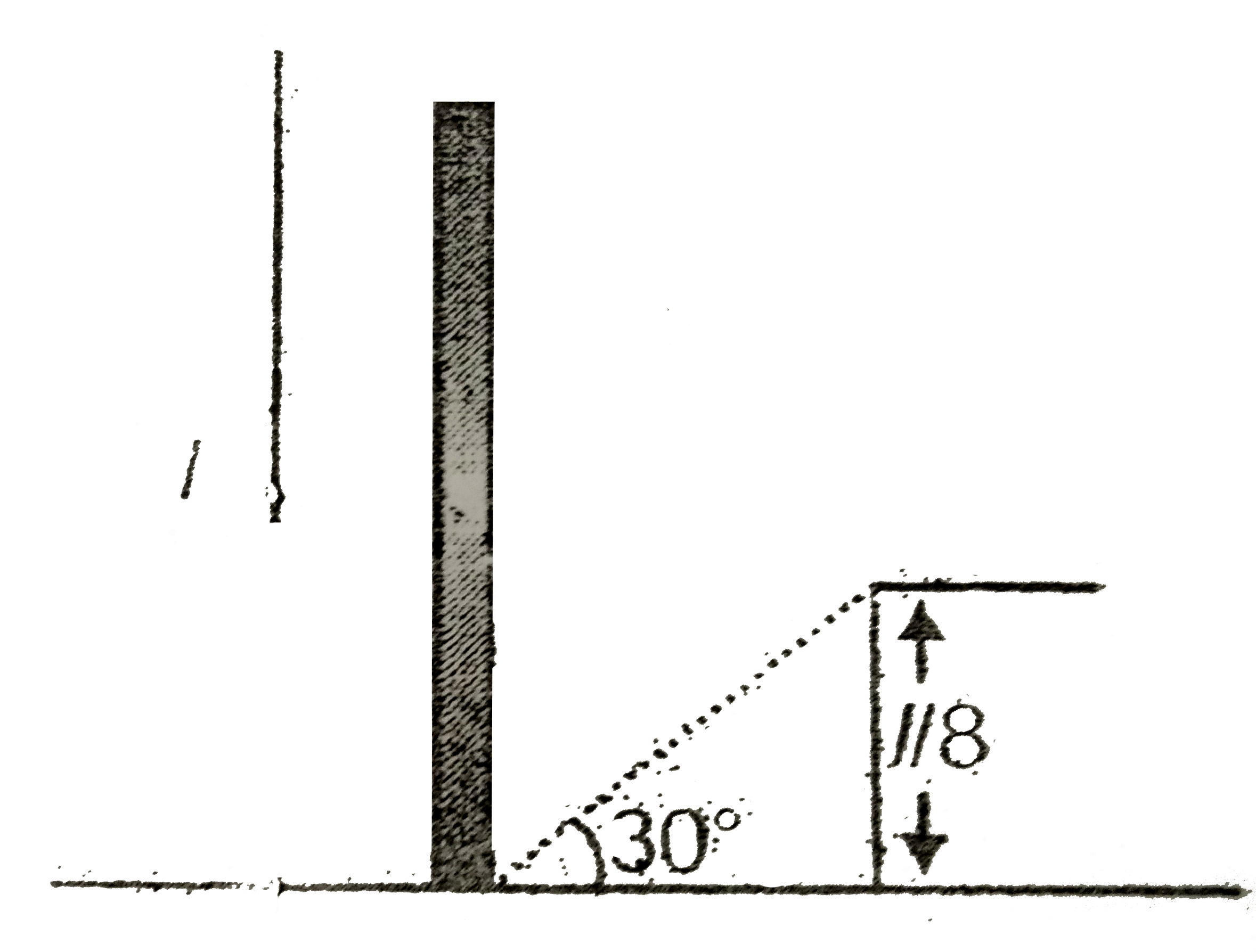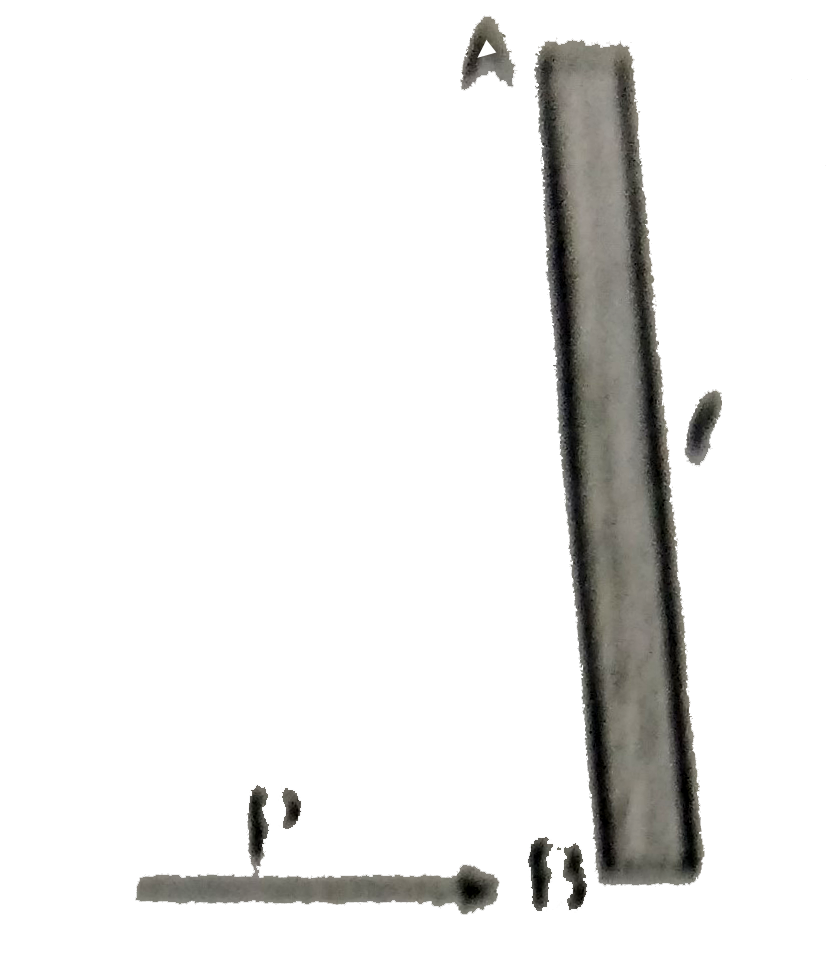A uniform rod OA of length l, resting on smooth surface is slightly distributed from its vertical position P is a point on the rod whose locus is a circle during the subsequent motion of the rod, then the distance OP is equal to 'l/4'. In the above question, the velocity of end O when end A hits the gournd is
zero
along the horizontal
along the vertical
at some inclination of the ground (≠90∘)
To solve the problem step by step, we can follow this approach:
Step 1: Understand the Setup
We have a uniform rod OA of length l resting on a smooth surface. The rod is slightly disturbed from its vertical position, and we know that point P on the rod moves in a circular path during the motion. We are given that the distance OP is equal to l4.
Step 2: Identify the Motion of the Rod
When the rod is disturbed, it starts to rotate about its end O as it falls. The motion of the rod can be analyzed using rotational dynamics. The center of mass of the rod will experience a downward acceleration due to gravity.
Step 3: Determine the Axis of Rotation
The instantaneous axis of rotation for the rod is at the point O when the rod is falling. As the rod rotates, the point A will eventually hit the ground.
Step 4: Analyze the Velocity of Point O
When point A hits the ground, we need to find the velocity of point O. Since the rod is rotating about point O, we can use the concept of angular velocity.
Step 5: Use Energy Conservation
To find the velocity of point O when point A hits the ground, we can use the principle of conservation of energy. The potential energy lost by the center of mass of the rod will convert into kinetic energy.
1. The center of mass of the rod is at a distance of l2 from point O.
2. The height dropped by the center of mass when the rod falls to the horizontal position is l2.
3. The potential energy lost is given by:
PE=mgh=mg(l2)
4. The kinetic energy gained by the rod when point A hits the ground is:
KE=12Iω2
where I is the moment of inertia of the rod about point O, given by I=13ml2.
Step 6: Relate Angular Velocity to Linear Velocity
The linear velocity v of point O can be related to the angular velocity ω by:
v=rω
where r is the distance from point O to point A, which is l.
Step 7: Set Up the Energy Equation
Setting the potential energy equal to the kinetic energy gives:
mg(l2)=12(13ml2)ω2
Step 8: Solve for Angular Velocity
Rearranging the equation, we find:
g(l2)=16l2ω2
ω2=3gl
Step 9: Calculate the Velocity of Point O
Using the relationship v=lω:
v=l√3gl=√3gl
Conclusion
Thus, the velocity of end O when end A hits the ground is:
v=√3gl
---
We have a uniform rod OA of length l resting on a smooth surface. The rod is slightly disturbed from its vertical position, and we know that point P on the rod moves in a circular path during the motion. We are given that the distance OP is equal to l4.
When the rod is disturbed, it starts to rotate about its end O as it falls. The motion of the rod can be analyzed using rotational dynamics. The center of mass of the rod will experience a downward acceleration due to gravity.
The instantaneous axis of rotation for the rod is at the point O when the rod is falling. As the rod rotates, the point A will eventually hit the ground.
When point A hits the ground, we need to find the velocity of point O. Since the rod is rotating about point O, we can use the concept of angular velocity.
To find the velocity of point O when point A hits the ground, we can use the principle of conservation of energy. The potential energy lost by the center of mass of the rod will convert into kinetic energy.
2. The height dropped by the center of mass when the rod falls to the horizontal position is l2.
3. The potential energy lost is given by:
PE=mgh=mg(l2)
KE=12Iω2
where I is the moment of inertia of the rod about point O, given by I=13ml2.
The linear velocity v of point O can be related to the angular velocity ω by:
v=rω
where r is the distance from point O to point A, which is l.
Setting the potential energy equal to the kinetic energy gives:
mg(l2)=12(13ml2)ω2
Rearranging the equation, we find:
g(l2)=16l2ω2
ω2=3gl
Using the relationship v=lω:
v=l√3gl=√3gl
Thus, the velocity of end O when end A hits the ground is:
v=√3gl
Topper's Solved these Questions
- BOOK - DC PANDEY ENGLISHCHAPTER - ROTATIONAL MECHANICSEXERCISE - Level 21videos
ROTATIONAL MECHANICS
- BOOK - DC PANDEY ENGLISHCHAPTER - ROTATIONAL MECHANICSEXERCISE - Level 2 Subjective36videos
ROTATIONAL MECHANICS
- BOOK - DC PANDEY ENGLISHCHAPTER - ROTATIONAL MECHANICSEXERCISE - Level 2 Single Correct26videos
ROTATIONAL MECHANICS
- BOOK - DC PANDEY ENGLISHCHAPTER - ROTATIONEXERCISE - (C) Chapter Exercises39videos
ROTATION
- BOOK - DC PANDEY ENGLISHCHAPTER - ROTATIONAL MOTIONEXERCISE - Integer Type Questions17videos
ROTATIONAL MOTION
Similar Questions
A uniform rod OA of length l resting on smooth surface slightly disturbed from its vertical position . P is a ipoint on the rod whose locus is a circle during the subsequent motion of the rod. the OP distance is l/4 . In the above question, the velocity of end A at the instant it hits the ground is
View SolutionA uniform rod of length l is slightly disturbed from its vertical position. Find the angular velocity of the rod just after if hits the step. (Friction is sufficient everywhere to prevent slipping)
 View Solution
View SolutionA uniform rod of length l and mass 2 m rests on a smooth horizontal table. A point mass m moving horizontally at right angles to the rod with velocity v collides with one end of the rod and sticks it. Then
View SolutionA uniform rod of length l and mass 2 m rests on a smooth horizontal table. A point mass m moving horizontally at right angles to the rod with velocity v collides with one end of the rod and sticks it. Then
View SolutionA uniform rod of length l is from rest such that it rotates about a smooth pivot. The angular speed of the rod when it becomes vertical is.
 .View Solution
.View SolutionA uniform rod of mass m, length l rests on a smooth horizontal surface. Rod is given a sharp horizontal impulse p perpendicular to the rod at a distance l/4 from the centre. The angular velocity of the rod will be
View SolutionA rod of length L is hinged from one end. It is brought to a horizontal position and released. The angular velocity of the rod, when it is in vertical position, is
View SolutionA uniform rod AB hinged about a fixed point P is initially vertical. A rod is released from vertical position. When rod is in horizontal position:

The acceleration of end B of the rod isView SolutionA rod of length L is hinged from one end. It is brought to the horizontal position and released. The angular velocity of the rod when it is in the vertical position is √Kg/L. Then find the value of K.
View SolutionA uniform rod AB of mass m and length l at rest on a smooth horizontal surface . An impulse P is applied to the end B. The time taken by the rod to turn through a right angle is :
 View Solution
View Solution

